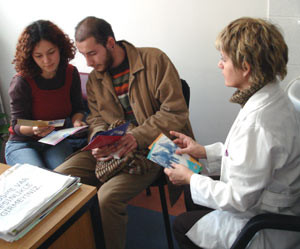News
Putting Evidence-Based Protocols into Practice
- 01 March 2008
News
UNITED NATIONS, New York — How does a health worker help a young couple decide which contraceptive is best suited to their needs?
At what point during a problematic delivery does a clinic midwife decide to rush the labouring woman to a district hospital?

Should a doctor prescribe antibiotics to an asymptomatic patient who may have been exposed to a sexually transmitted infection?
These are the kinds of questions health workers in the field confront on a daily basis. The wrong responses mean that clients do not receive the quality of care they are entitled to. In some cases, they can mean the difference between life and death. If all health providers have the tools to reach the right decisions, however, outcomes throughout a health system can markedly improve.
|
"This has been a very efficient way for two agencies working together with governments and other partners to make available the latest scientific research available to end-users in the developing world. "
--Dr. Nuriye Ortayli
|
That’s why the World Health Organization, with help from its partners, including UNFPA, the United Nations Population Fund, have invested so much time and effort into publishing guidelines and decision trees and protocols that reflect the highest medical standards. To produce them, experts have pored over technical journals, sifted through evidence, engaged in extensive consultations with both medical and communications professionals, and gone through rounds of review and revision to arrive at a consensus.
The process results in comprehensive, evidence-based publications like the following, which have also been translated into all five UN languages:
However, these are not simply documents to be distributed. They are manuals that offer the promise of transforming health care practices and strengthening health systems. But in order for that to happen, they need to be carefully introduced to providers through a well-planned process and adapted as circumstances warrant. Otherwise, they may sit on bookshelves and go unused by the people who need them.
Changing the way people practice medicine is not a simple matter. Providers need to be convinced of the need for change. They need to be trained in how to carry out new procedures or protocols. They need encouragement from supervisors. They need materials and adequate supplies. Unless such issues are taken into consideration, changes are unlikely to be widely adapted or sustained.

In response, UNFPA and WHO have collaborated on a programme to address these concerns. It includes a situation analysis as well as workshops to carefully introduce technical guidelines, adapt them to the specific language or national context, and ensure they are widely adopted. It can be a long and painstaking process, but one that is necessary to producing sustained results.
This Strategic Partnership Programme, as this collaboration is called, has been well-received in more than 30 countries (the evaluation report notes that it has had almost universal approval). It has focused on improving service delivery in the areas of family planning, prevention and care for sexually transmitted and reproductive tract infections, and maternal and newborn health. In some countries, such as Mongolia and Myanmar, the guidelines have been used in the updating of graduate and post-graduate curricula, thereby institutionalizing the practices and protocols.
More than 31 other countries have participated in regional workshops, which also afford a rich opportunity for interagency collaboration and knowledge sharing. "This has been a very efficient way for two agencies working together with governments and other partners to make the latest scientific research available to end-users in the developing world,” said Dr. Nuriye Ortayli, an advisor on the program for UNFPA.
Here are some examples of how this collaboration takes shape on the ground.
China has piloted implementing guidelines at all levels – from the district to the townships to the smallest villages – to ensure that end-users far from large medical facilities can get the benefit the offer.
In Indonesia , the WHO manual on diagnosing and treating sexually transmitted and reproductive tract infections was translated, adapted and field tested. The adaptation process included intensive discussions that took cultural issues as well as national standards and available medicines into consideration.
In Peru , workshops to train trainers on the content and use of revised national guidelines have been organized in five regional Centres for Development of Competencies. Among the groups who have been involved in the process are the Peruvian Obstetrics and Gynaecology Society, national universities, regional health directorships and the National Health Institute.
In the South Pacific, after the distribution of brochures, wall charts and other tools to help providers and clients to make sound contraceptive choices, demand for contraceptives increased so much that clinics ran out of supplies. UNFPA then helped countries meet the higher demand.
In Turkmenistan , guidance on family planning and management of sexually transmitted infections is being integrated into national guidelines for primary health care providers.
— Janet Jensen